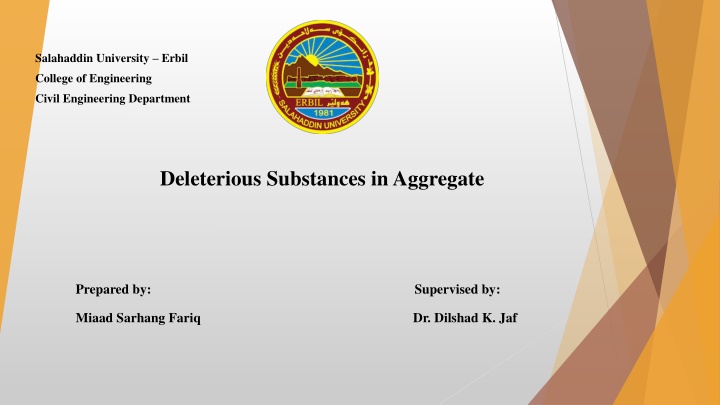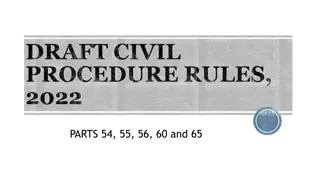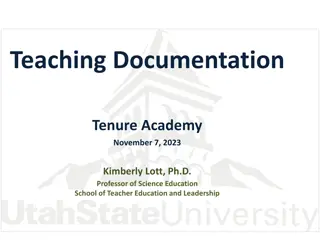
Managing Deleterious Substances in Concrete Aggregates
Learn about the impact of deleterious materials in concrete aggregates on strength, workability, and long-term performance. Discover the importance of ensuring aggregates are free from impurities to maintain the durability and quality of the concrete. Explore the types and effects of various deleterious substances found in aggregates.
Download Presentation

Please find below an Image/Link to download the presentation.
The content on the website is provided AS IS for your information and personal use only. It may not be sold, licensed, or shared on other websites without obtaining consent from the author. If you encounter any issues during the download, it is possible that the publisher has removed the file from their server.
You are allowed to download the files provided on this website for personal or commercial use, subject to the condition that they are used lawfully. All files are the property of their respective owners.
The content on the website is provided AS IS for your information and personal use only. It may not be sold, licensed, or shared on other websites without obtaining consent from the author.
E N D
Presentation Transcript
Salahaddin University Erbil College of Engineering Civil Engineering Department Deleterious Substances in Aggregate Prepared by: Supervised by: Miaad Sarhang Fariq Dr. Dilshad K. Jaf
DELETERIOUS MATERIALS IN AGGREGATES Deleterious materials in aggregate are those substances which detrimentally effect the fresh and hardened properties of concrete for instance strength, workability, and long-term performance of the concrete. The natural rock and gravel sources of aggregates may contain components which are potentially deleterious when the aggregate is used in concrete and mortar. These deleterious materials may be distributed throughout the entire rock or deposit, be confined to only a part of it, or alternatively be present in a particular localized feature within the source rock or deposit. A geological evaluation of the source combined with a thorough petrological investigation and appropriate testing will minimize the risk of deleterious materials being incorporated into the concrete or mortar.
Concrete aggregates should be free from impurities and deleterious substances, why? interfere with the process of hydration. prevent the effective bond between the aggregates and matrix. reduce the durability of the aggregate and concrete.
Types and Effects of Deleterious Substances inAggregate Types Main effect Additional effect - Clay coatings on aggregate particles Physical prevention of good bond between the aggregate and the cement paste Clay lumps and altered rock particles Interaction between the cement paste and the aggregate which continues after hardening, sometimes expansion and cracking of the concrete Modification of the properties of the fresh concrete to the detriment of the durability and strength of causing Absorptive and microporous particles Weakness and poor durability of the aggregate particles themselves Coal and lightweight particles - Weak or soft particles and coatings Weakness and poor durability of the aggregate particles themselves Physical prevention of good bond between the aggregate and the cement paste Modification of the properties of the fresh concrete to the detriment of the durability and strength of Interaction between the cement paste and the aggregate which continues after hardening, sometimes causing expansion and cracking of the concrete
Types and Effects of Deleterious Substances in Aggregate Types Main effect Additional effect Organic matter Chemical interference with the setting of concrete Modification of the properties of the fresh concrete to the detriment of the durability and strength of Modification of the properties of the fresh concrete to the detriment of the durability and strength of Mica Weakness and poor durability of the aggregate particles themselves The main problem with chlorides in concrete is associated with the corrosion of embedded steel Chlorides Interaction between the cement paste and the aggregate which continues after hardening, sometimes causing expansion and cracking of the concrete Sulfates Weakness and poor durability of the aggregate particles themselves Interaction between the cement paste and the aggregate which continues after hardening, sometimes causing expansion and cracking of the concrete
Types and Effects of Deleterious Substances in Aggregate Types Main effect Additional effect Pyrite (iron disulfide) Interaction between the cement paste and the aggregate which continues after hardening, sometimes causing expansion and cracking of the concrete Weakness and poor durability of the aggregate particles themselves Chemical interference with the setting of concrete - Soluble lead, zinc or cadmium - Alkali-reactive constituents Interaction between the cement paste and the aggregate which continues after hardening, sometimes causing expansion and cracking of the concrete Interaction between the cement paste and the aggregate which continues after hardening, sometimes causing expansion and cracking of the concrete Physical prevention of good bond between the aggregate and the cement paste Releasable alkalis -
Interference with the setting of the concrete chemical contaminants ( soluble chlorides and sulphates ) organic compounds ( mono- and polysaccharides, humic acid and lignins ) soluble salts of (lead, zinc, cadmium and tin) can retard the setting of cement, and hence affect the final strength and durability of concrete. The natural rock and gravel sources of aggregates may contain components which are potentially deleterious when the aggregate is used in concrete and mortar. Chloride reduces the protection of reinforcing steel from corrosion (passivation) and leads to rust forming on the surface of the steel. The rust occupies a much greater volume than the original steel thus disrupting and cracking the concrete as well as weakening the all important concrete steel bond and the steel itself. Carefully measured amounts of gypsum (hydrated calcium sulphate) are normally added to Portland cement to control its setting characteristics, but additional amounts derived from the aggregate could produce deleterious expansion and disruption of the concrete through internal sulphate attack.
Modification to the strength and durability characteristics of a concrete Although small amounts of dust are helpful in concrete, improving cohesiveness and reducing bleeding, excessive amounts may cause the aggregate particles to become coated with dust so that the necessary bonding between the particle and the cement matrix is not fully established. Interaction between aggregate particles in a concrete or mortar and constituents from the cement binder can also lead to longer-term durability problems. The best known of these are the alkali- aggregate reactions between certain types of siliceous or carbonate aggregates and the alkalis normally derived from the cement. The alkali silica reaction involves aggregates which are composed of (or contain) non-crystalline or poorly crystalline silica or siliceous glass which can react with the alkali hydroxides derived from the cement. In time, the reaction product which is an expansive hydroscopic gel, can exert sufficient pressure to crack and disrupt the concrete. Certain impure carbonate aggregates will also react with alkalis in the pore fluid (referred to as the alkali carbonate reaction) and can also cause expansion and disruption of the concrete. The nature of the pore structure and pore size distribution, particularly the microporosity, appears to be more critical than the overall porosity of the aggregate in relation to its resistance to freeze thaw in concrete, so that each aggregate source needs to be assessed individually. Some flints which occur in southern England have a white microporous flint outer layer or cortex which may be present as discrete particles or surface coatings in an aggregate and these can cause spalling and pop-outs from concrete surfaces under freeze thaw conditions
Unsound aggregate particles in concrete A wide range of aggregate materials contain unsound particles, present either as natural components in the aggregate source material or as contaminant particles from an extraneous source. They can produce problems when incorporated into a concrete which range from surface cosmetic disfigurement to reduction in the compressive strength, or a reduction in durability. One of the commonest unsound particle contaminants familiar in the gravel aggregates of southern Britain is pyrite (iron disulphide). This mineral can oxidize to brown iron hydroxides in normal environmental weathering conditions if close to the surface of a concrete. some Cornish tin mining wastes contain pyrite crystals, or mundic particles, (mundic is the old Cornish word for pyrite). This material is used as low-grade aggregate for the production of concrete blocks and the pyrite does contribute to the deterioration of concrete, although moisture movement in the clay and the secondary micas which are present in the slaty and phyllitic waste is also involved. Aggregate particles partly composed of clay and certain geologically weathered rocks tend to be moisture sensitive, that is, they have the capacity to absorb or lose water from their structure depending on the environmental conditions. This produces a consequent expansion or shrinkage of the particle leading to the breakdown of the aggregate/cement bond so that the concrete becomes susceptible to damage by frost and thermal cycling.
Chalk particles present in some gravel aggregate sources as shown in figure can also reduce the quality of a concrete. Chalk aggregate particles, like clay lumps and other soft materials, are weak and can reduce the compressive strength and durability of the concrete. However, a fraction of the chalk appears to be broken up and becomes involved in the hydration and setting of the cement matrix with uncertain consequences. Thus only a proportion of the original chalk particles remain as true aggregate, nevertheless a small percentage of chalk in the aggregate is sufficient to reduce the strength of a concrete significantly. Varying amounts of coal and lignite particles are found in some gravel aggregates and also in some mine wastes. They tend to form weak and porous particles in the aggregate, and may also form unsightly tarry stains on concrete surfaces, or be the cause of surface pitting Mica as a constituent of a sand fine aggregate usually increases the water demand of a concrete and because of flaky shape and surface texture tends to reduce the cohesiveness of the mix. Small percentages of mica in the fine aggregate can reduce the final compressive strength of a concrete significantly. In one example from south-west England strength was reduced by 5 per cent for 1 per cent by weight of discrete mica particles in the total aggregate. Many sea-dredged and some land-based gravel resources contain carbonate shell fragments. Although these fragments are usually mechanically strong complete shells may be hollow and other fragments flaky, may reduce the workability of a concrete mix and hollow shells may reduce the strength of the concrete. However, unless the proportion of shell in the aggregate is very high the effects of shell on the workability and strength of concrete are minimal
Effectiveness of these materials can be measured by: Measuring compressive strength of concrete manufactured by the suspected aggregate in comparison with concrete manufactured by good quality aggregate. Loss of strength more than 10 % , is not allowed. To determine the organic content of aggregate, colorimetric test recommended by ASTM C 40-92. Since no test is available to determine separately the clay content, silt and dust, the limits of fine materials are prescribed in terms of the percentage of material passing 75 m (No. 200) sieve.






















